Bloodroot, Red Indian Paint, Red Puccoon - Sanguinaria canadensis
|
Sanguinaria canadensis - Bloodroot, Red Indian Paint, Red Puccoon. Sanguinaria is a monotypic genus - Bloodroot is the only species in it. It is one of about 60 - 65 species in the Poppy family (Papaveraceae) in North America. It is found only in North America. It is most closely related to Eomecon chionantha, a plant native to China which has the common name of Snow Poppy or Dawn Poppy.
Sanguinaria canadensis (syn. Sanguinaria australis) is a beautiful, white, early spring wildflower. Bloodroot gets its name from the red juice of the root, caused by the compound sanguinarine. While sanguinarine has anti-bacterial and anti-fungal characteristics, it can be toxic, so do not ingest it.
Found in:
AL, AR, CT, DC, DE, FL, GA, IA, IL, IN, KS, KY, LA, MA, MD, ME, MI, MN, MO, MS, NC, ND, NE, NH, NJ, NY, OH, OK, PA, RI, SC, SD, TN, TX, VA, VT, WI, WV
Journal Articles Referencing Bloodroot
Leave comments on Sanguinaria canadensis at this link. | 
Distribution of Sanguinaria canadensis in the United States and Canada:

Blue=Native; Grey=Introduced
Map from USDA Plants Database:
USDA, NRCS. 2017. The PLANTS Database (http://plants.usda.gov, 08 May 2025). National Plant Data Team, Greensboro, NC 27401-4901 USA.
Search Our Database: Enter any portion of the Scientific, Common Name, or both.
Do a general Google search of the entire site:
#ad
 Follow USWildflowers on Twitter
#ad
| | Site: The Pocket at Pigeon Mountain, Walker County, GA Date: 2009-March-07 | Photographer: Gerald C Williamson
Nikon D60
1/200f/8 ISO100
Nikon Nikkor AF-S 55-200mm 4-5.6G ED
185mm (277 equiv) | | Bloodroot blooms in the early spring with a beautiful blossom having white petals and many golden-yellow stamens. The green pistil is usually less prominent than in this photo, being hidden among the stamens. | | 
| | Site: The Pocket at Pigeon Mountain, Walker County, GA Date: 2009-March-01 | Photographer: Gerald C Williamson
Nikon D60
1/125f/5.6 ISO100
Nikon Nikkor AF-S 55-200mm 4-5.6G ED
200mm (300 equiv) Flash: Yes | | This is what Sanguinaria canadensis looks like as it first emerges from the ground in spring - a single leaf tightly wrapped around the flower bud, both on a single stem. | | Click on the photo for a larger image
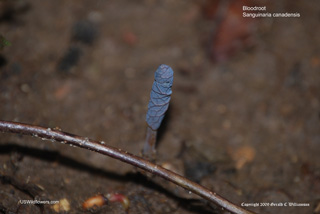
| | Site: The Pocket at Pigeon Mountain, Walker County, GA Date: 2009-February-21 | Photographer: Gerald C Williamson
Nikon D60
1/4f/8 ISO100
Nikon Nikkor AF-S 55-200mm 4-5.6G ED
200mm (300 equiv) | | Once the leaf unclasps the flower bud, it rises above the leaf on its peduncle. Here you see the blossom's 2 sepals separating to expose the petals, which are pink at this stage, but will turn white as they open. The sepals will drop off soon after the blossom opens. | | Click on the photo for a larger image
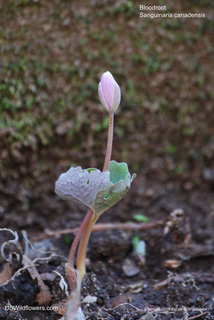
| | Site: The Pocket at Pigeon Mountain, Walker County, GA Date: 2008-March-26 | Photographer: Gerald C Williamson
Nikon D40
1/125f/5.6 ISO500
Nikon Nikkor AF-S 55-200mm 4-5.6G ED
200mm (300 equiv) | | The bloodroot leaf stays close to the blossom with which it shares a stem arising from the rhizome. The 9-lobed leaf will continue to grow after flowering and may reach 8 inches across. The flower in this photograph has 15 petals, more than most. While some publications say bloodroot has 8-10 petals, I've found numerous plants with more. | | Click on the photo for a larger image
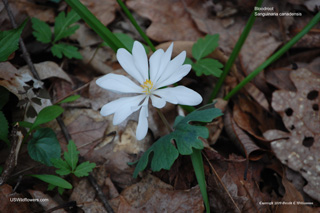
| | Site: The Pocket at Pigeon Mountain, Walker County, GA Date: 2009-March-09 | Photographer: Gerald C Williamson
Nikon D60
1/125f/5.6 ISO180
Nikon Nikkor AF-S 55-200mm 4-5.6G ED
185mm (277 equiv) Flash: Yes | | Numerous bloodroot leaf/flower stems can arise from a single plant rhizome, giving the apearance of a colony of plants. | | Click on the photo for a larger image
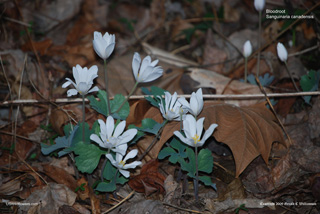
| | Site: The Pocket at Pigeon Mountain, Walker County, GA Date: 2015-March-16 | Photographer: Gerald C Williamson
Nikon D7000 | | The flowering scape of Sanguinaria canadensis grows to about 8 inches tall, although it can be much shorter - I've seen the flower resting on forest duff. I've not seen any of them "straining for the sun" more than this one. | | Click on the photo for a larger image
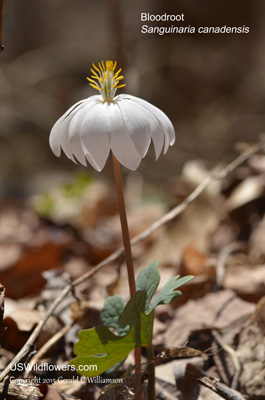
|
References used for identification and information:
|
|
| |
| #ad
|
|








